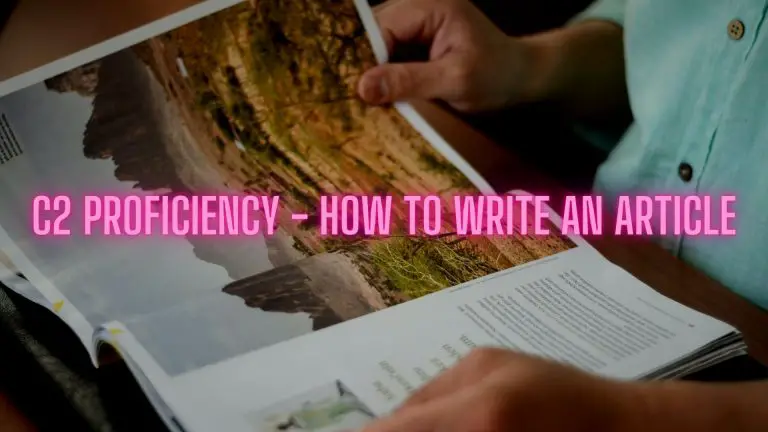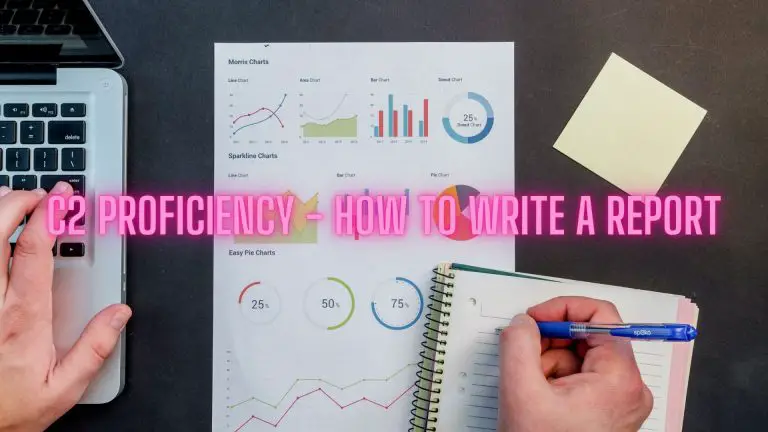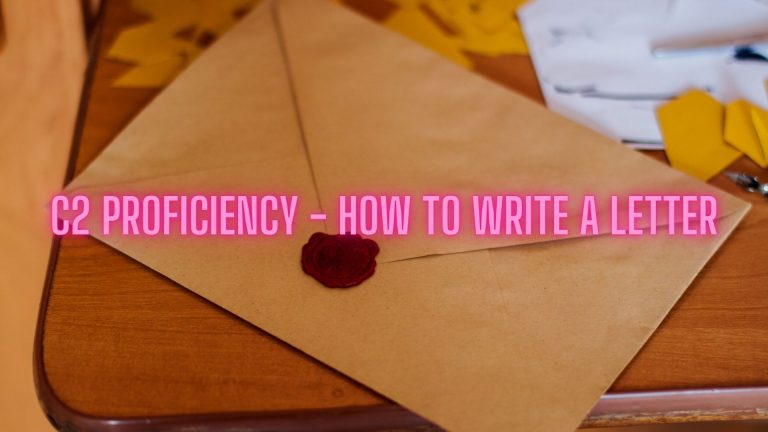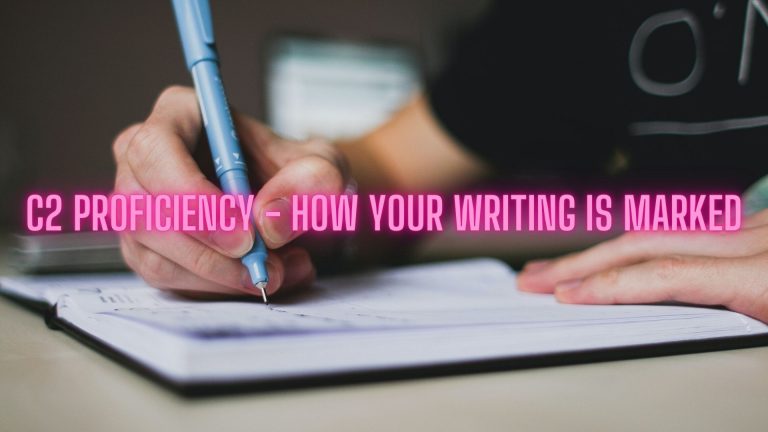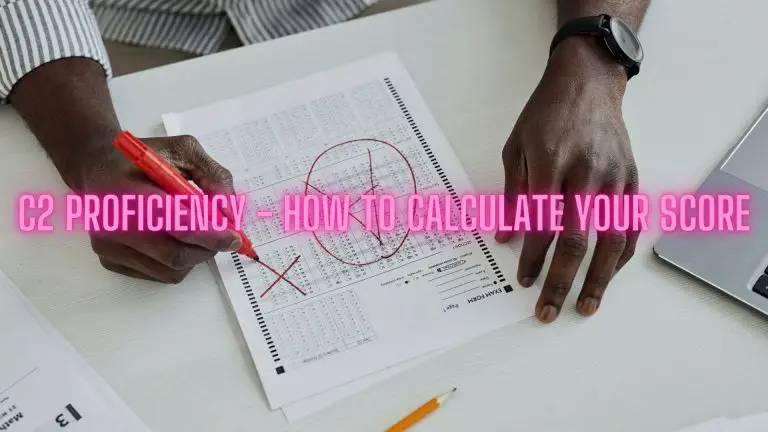Overview
- Mandatory task: no
- Word count: 280-320
- Main characteristics: descriptive, narrative, evaluative, recommendations/suggestions
- Register: depends on the task
- Structure:
Introduction
A review may be about a book, magazine, film, play, or concert, but it may also be about, for example, an exhibition. The target reader is specified in the question, so the candidate knows not only what register is appropriate, but also has an idea about the kind of information to include. A review does not merely require a general description of, for example, an event or publication, but it specifies the particular aspects to be considered. For example, the review may employ narrative, as well as descriptive and evaluative language, and a range of vocabulary relating, for example, to literature and the media such as cinema or TV.
Source: Cambridge English Assessment: C2 Proficiency Handbook for teachers
Reviews are one type of text in Cambridge C2 Advanced that you don’t have to do but you can choose to do it together with articles, reports and formal/informal letters while essays are the only mandatory task in the writing test.
One of the easier tasks
I find reviews to be quite popular among my students because they are very common and really part of our everyday lives. Whenever we try to check out a new restaurant, film, book or experience when we are on holiday, we have a look at what other people think, who have already bought or done it.
That’s why writing reviews comes fairly naturally to many people simply because we see them all the time. We know that a good review is interesting, informative and persuasive and if you can do these things in the exam, you are good to go.
Of course, there are always certain criteria you need to keep in mind, but that’s what I’m here for, so let’s get into it.
What a typical review task looks like
First of all, it is a good idea to have a look at a task and get as much information from it as possible.

We usually want to find out three things that help us prepare for writing a great review:
- What is the topic of the task?
- What exactly do I have to include in the review?
- Who is going to read the review?
The topic of the review is children’s books and you have to talk about one that you enjoyed as child and would recommend even today. To be more specific, you have to say what you liked about it and why you think children today would still get something out of it.
Last but not least, you are writing for the readers of a literary magazine, which tells us that we shouldn’t write in a style that it too informal, but I also wouldn’t write as formally as in an essay. So, we ought to keep the style of language neutral, meaning that we can include some phrasal verbs and other smaller informal features like contractions (e.g. I’m or don’t), but I recommend not using any colloquial expressions that we typically use in spoken English.
How to organise your review
Reviews in C2 Proficiency can normally be structured in a similar way because the different elements we need to include are always the same: a descriptive part, something we need to discuss in a bit more detail, and a recommendation.
- Title & introduction
- Description
- Discussion
- Recommendation
This commonly works very well. You can, of course split up the descriptive part or the discussion part in several paragraphs if it makes sense and at this level, you should definitely be able to make any task work for you, but this is a good basic scaffold that you can utilise in your writing.
Don’t forget to plan your review
Creating a plan before you start writing is an essential element of a good strategy in C2 Proficiency and I strongly suggest not skipping this step. It helps you to put your thoughts in order, which, in turn, can save you a lot of time when you are bringing them to paper.
The easiest way to create a plan is to take the paragraph structure you want to apply and to make some notes for each part:
- Title & introduction: Pippi Longstocking; Astrid Lindgren; 1945; childhood memories
- Description: young girl living by herself with her horse and monkey; super strength; Tommy and Annika; brave; adventures
- Discussion: I love her fearlessness, adventures and colourful world; children nowadays overprotected –> can benefit from a strong character like Pippi
- Recommendation: strongly recommend it; good entry to literature; good example of badass girl
Making the plan was a 4-minute effort and now I’m set and ready for my awesome review. The plan will keep me on track and I won’t have to think about the content anymore. All I have to do is turn my notes into full sentences and focus on good language.
The different parts of a review
Everything I’ve told you up to this point has been about getting yourself ready for the actual writing. We have a paragraph structure we can trust as well as an outline of our ideas. Now, we are going to look at an example and I will explain to you what my thought process looks like.
Title & introduction
The introduction in a review has a very straightforward purpose: engage the reader and make interesting from the beginning. I like doing that by asking a question, which involves the reader immediately, including some kind of personal anecdote as well as some very basic facts about the topic of the review, in this case the name of the book and the author.
Pippi Longstocking by Astrid Lindgren
Do you still know your favourite story from your childhood? I remember listening to my dad reading stories to me and my sister after lunch every day and my most treasured book was about a brave little girl called Pippi Longstocking written by the Swedish author Astrid Lindgren in 1945.
Every review gets a title, which doesn’t have to be anything spectacular but make sure that your text has one. Then, you can see that I basically just included the different things I mentioned earlier: a question (“Do you still know …?”), a personal anecdote (“I remember listening …”) and some factual info about the book itself. Mission accomplished. The reader is hooked and we can move on to the next part.
Description
The second paragraph is there to talk a little bit more about the subject of your review. In the case of a book you want to give more information, for example, who the main characters are, where and when the story is set, etc. For a review of a restaurant you might mention the location and the cuisine they serve there or why you went there in the first place. I guess you get the idea. Describe what the task wants you to describe and make sure that your language is on point.
Pippi is a nine-year-old girl who lives in her own house called Villa Villekulla together with her meerkat, Mr. Nillson, and a horse. Not only is she an exceptionally brave girl that goes on many adventures with her best friends Annika and Tommy, but she also possesses superhuman strength, which she often shows off throughout the story, for example, by lifting the horse in the air with her friends sitting on it.
Here you can see that I give a breakdown of the main characters as well as the general setting of the story. You don’t want to give too many spoilers because no one likes that, right?

Thanks to my plan I didn’t have to worry about the content, but I was able to focus on the language. I’ve included some nice vocabulary and grammar (not only, but also; exceptionally brave; superhuman strength; which; shows off) to keep the reader engaged.
Discussion
The discussion portion of a review always asks you to give your opinion on some aspect of the experience. In our example task, we have to say what we enjoyed about the book when we read it and why we think children today might still like it.
We could definitely split this part into two paragraphs, but I made it work in just one.
The excitement I felt back then is still very vivid in my memories. I loved Pippi’s fearlessness and her constant appetite for adventure as well as the colourful world with all its odd characters Astrid Lindgren brings to life. I’m sure that I would still enjoy the book if I ever decided to pick it up again and its timeless character makes Pippi Longstocking a great choice even for children today. In a world where many parents try to bubble wrap their kids and control every aspect of their lives, a rebel like Pippi can be the perfect antidote to that. Young people can learn what it means to confront and even thrive in the face of a challenge instead of avoiding it, which I believe is a very useful quality to have in life.
First, I give reasons for why I liked the story (fearlessness, appetite for adventure, colourful world) and then I project those aspects onto children’s lives today with their very scheduled weeks and little room for creativity and enjoyment while being encapsulated by their helicopter parents (Google it, it’s a real expression.).
With the first sentence I link this paragraph to the introduction and the different aspects in this section are all well connected using different cohesive devices (as well as, I would still enjoy; a great choice even for children today). Use the freedom you have in a review to link everything well and make it as easy as possible for the reader to follow your logical arguments.
Recommendation
The last part of a review should always be a final recommendation. This doesn’t have to be anything special, but this is why we read a review in the first place. We want to know if the writer thinks we should consume or experience the same thing or not.
Long story short, I would highly recommend the story to parents who want to offer their children an entry point into literature and a world full of wonder and excitement that they can share with Pippi Longstocking in a time when their daughters and sons need it more than ever.
Once again, I didn’t reinvent the wheel here. I make my recommendation and try to connect this paragraph to the previous one (“… in a time when their daughters and sons need it more than ever”). With a sprinkle of interesting language (long story short; a world full of wonder and excitement) we bring our review to a close.
Feeling ready for a review now?
By now, you probably can’t wait to start practising. Reviews in Cambridge C2 Proficiency are really not that difficult, especially if you know what you’re doing. Keep in mind the different typical aspects of a review (paragraph structure, planning, interesting and engaging language) and I don’t see how you can ever write a bad review ever again.
If you are interested, I can also help you with some writing feedback or even private classes. Until then, all the best.
Lots of love,
Teacher Phill 🙂


